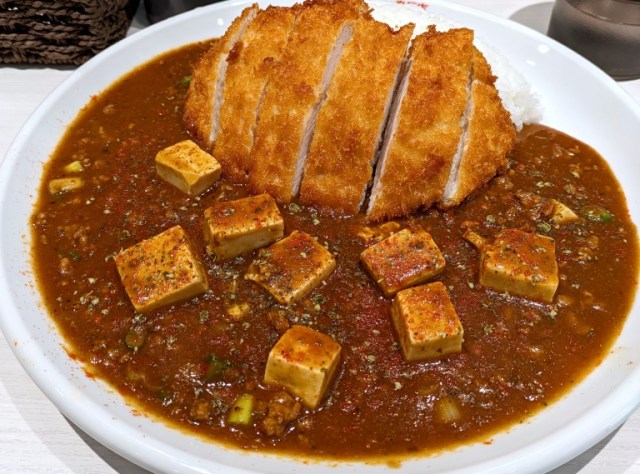
One plate with two great tastes that somehow create a third.
Glancing at the photo above, you might be thinking it’s a plate of curry rice, with a nice cutlet added in to make it especially satisfying. But look at it a little longer, and you might notice that the roux is a different color than curry usually is in Japan, with a reddish tint to it, and you might also think it’s strange that the potatoes are chopped into cubes.
But the truth is that those aren’t potatoes, they’re tofu, and this isn’t a plate of ordinary curry rice, it’s a plate of mabo curry, served up by restaurant chain Mabokari.
▼ Mabokari’s branch in Tokyo’s Shinjuku neighborhood is easy to spot even if you can’t read the restaurant’s written-in-Japanese name (マボカリ) thanks to its eye-catchingly colorful storefront.
Mabo tofu is what Japan calls mapo tofu, the spicy Sichuan tofu dish. In Japan, both curry and mabo tofu are customarily served poured over rice, and so Mabokari mixes them together to create a hybrid dish, mabo curry.
Mabokari isn’t the only restaurant in Japan that serves mabo curry, but the dish is relatively hard to find. Mabokari is also the only chain which makes mabo curry its signature dish, so when the chain, which started out in Osaka, made its way to Tokyo with its Shinjuku branch, we put it on our to-eat list, which led to our visit on a recent afternoon.
To order, you purchase a meal ticket from a vending machine at the entrance, which you then hand to the staff. The big button at the top left of the below photo (麻婆カレー) is the one for mabo curry, with the one to its right being for straight mabo tofu, and the one to the right of that omelet mabo curry.
We opted, of course, for the mabo curry, at the standard spiciness level, with a torikatsu/chicken cutlet as a topping, which came to 1,180 yen (US$7.90).
Visually, it’s very impressive, with a big beautiful cutlet sitting in a sea of mabo tofu sauce and curry roux, with a little archipelago of tofu.
We were curious to see whether the flavor would be more curry or more mabo, so we lifted up a spoonful to take a taste, and…
…the results were inconclusive. We could taste both curry and mabo tofu here, with the overall effect being right in the middle of what we associate with those two comfort foods.
This would require further testing, but at this point we’d also reached the limit of our willpower as far as resisting the urge to start eating the cutlet. So we grabbed the bottle of cutlet sauce on our table…
…poured some on, and took a bite.
It was outstanding. The chicken breast was a nice, thick cut, and the thin breading had a pleasant crispness to it that made for an excellent contrasting combination with the creamy texture of the curry roux/mabo tofu sauce mixture.
Then it was back to trying to figure out if the mixture tastes more like curry or more like mabo tofu sauce.
After many, many more mouthfuls, if we had to pick one of the other, we’d say it has, by only a very small margin, stronger mabo tofu vibes.
If we had to say why, though, really the only reason we’ve got is that there’s tofu on the plate too, which is something we mentally associate with mabo tofu but not curry. If you took out the tofu cubes and replaced them with chopped potatoes, we’d probably then say that it felt a little more like curry.
It’s all very much in keeping with the sign at the entrance, which says “People who have eaten it will tell you. ‘It’s not curry, and it’s not mabo tofu.’ It’s Mabokari.”
For as hard as its flavor is to pin down, though, this mabo curry tastes good enough that it’s very easy to love.
Restaurant information
Mabokari (Shinjuku Nishiguchi branch) / マボカリ(新宿西口店)
Address: Tokyo-to, Shinjuku-ku, Nishi Shinjuku 1-19-4
東京都新宿区西新宿1-19-4
Open 11 a.m.-11 p.m.
Photos ©SoraNews24
● Want to hear about SoraNews24’s latest articles as soon as they’re published? Follow us on Facebook and Twitter!
[ Read in Japanese ]

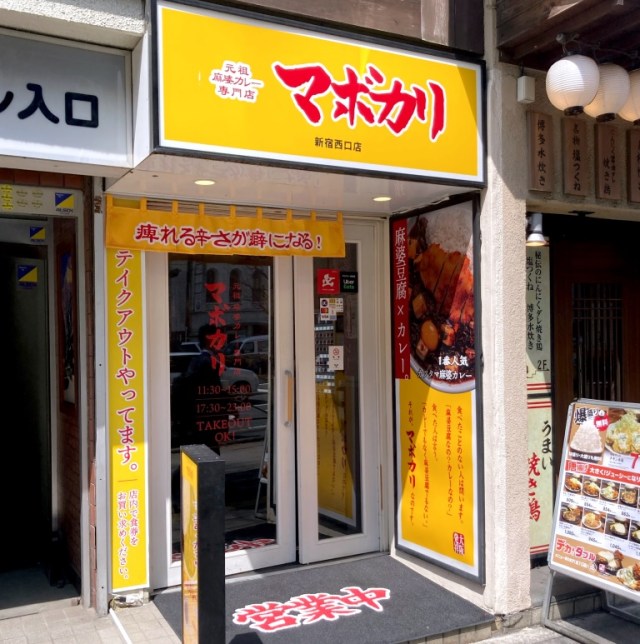
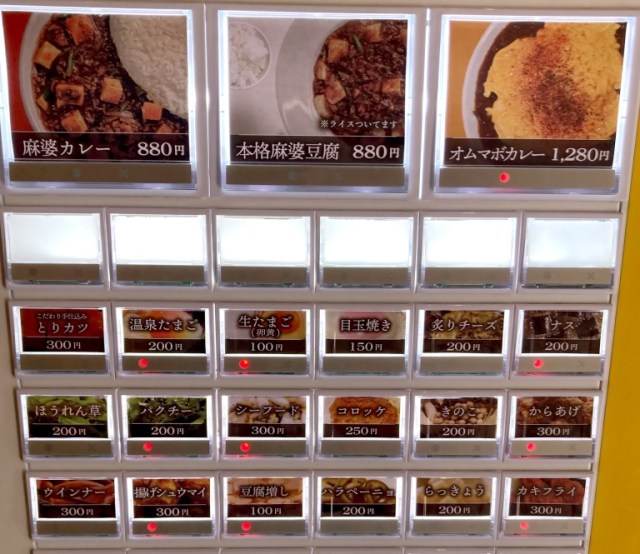
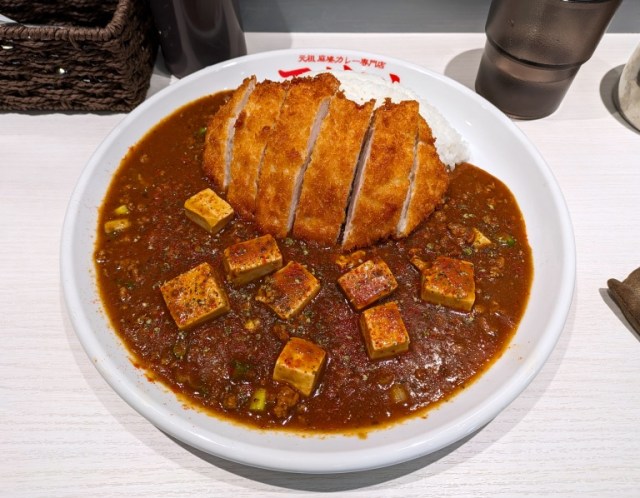
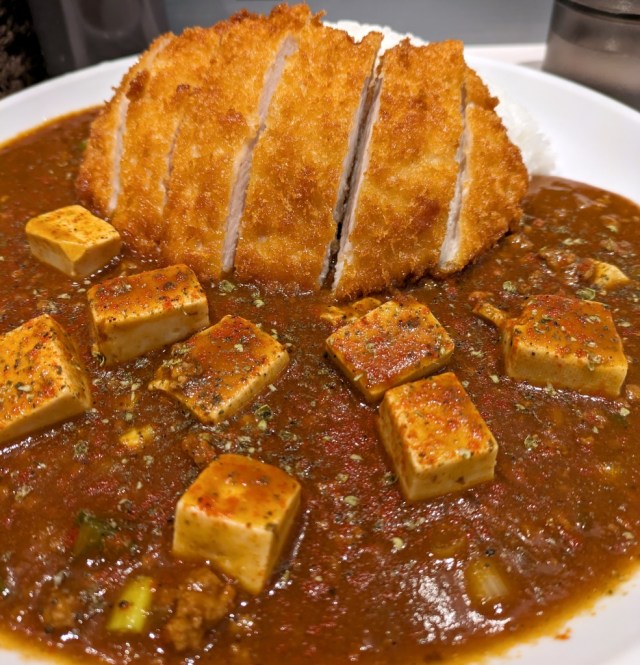


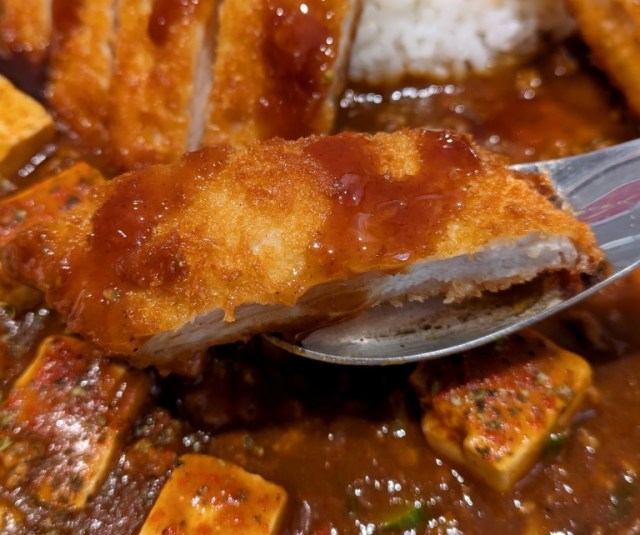



 We visit the restaurant where Prime Minister Abe ate with reporters, since he didn’t invite us
We visit the restaurant where Prime Minister Abe ate with reporters, since he didn’t invite us Time to drink Ippudo tonkotsu ramen broth from a can, only at Japanese vending machines
Time to drink Ippudo tonkotsu ramen broth from a can, only at Japanese vending machines Eat like the judges and lawyers of Japan at this theme restaurant in Kumamoto
Eat like the judges and lawyers of Japan at this theme restaurant in Kumamoto Japan’s most popular curry chain now has vegan soup curry, and it’s delicious【Taste test】
Japan’s most popular curry chain now has vegan soup curry, and it’s delicious【Taste test】 What’s the real meaning of Japan’s “burning tofu” emoji?
What’s the real meaning of Japan’s “burning tofu” emoji? Japan’s new difficult-to-drink-from beer glass protects your liver, but it’s a brutal experience
Japan’s new difficult-to-drink-from beer glass protects your liver, but it’s a brutal experience How to order snacks on a Shinkansen bullet train in Japan
How to order snacks on a Shinkansen bullet train in Japan New samurai glasses are Japan’s latest weird must-have souvenir
New samurai glasses are Japan’s latest weird must-have souvenir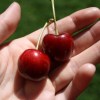 “Deflowering” services for virgin women are now a thing in Japan, apparently
“Deflowering” services for virgin women are now a thing in Japan, apparently Doraemon found buried at sea as scene from 1993 anime becomes real life【Photos】
Doraemon found buried at sea as scene from 1993 anime becomes real life【Photos】 Burger King Japan suddenly adds Dr. Pepper and Dr. Pepper floats to its menu nationwide
Burger King Japan suddenly adds Dr. Pepper and Dr. Pepper floats to its menu nationwide Hello, cosmetics! Clinique teams up with Hello Kitty this summer for first-time collaboration
Hello, cosmetics! Clinique teams up with Hello Kitty this summer for first-time collaboration Princesses, fruits, and blacksmiths: Study reveals the 30 most unusual family names in Japan
Princesses, fruits, and blacksmiths: Study reveals the 30 most unusual family names in Japan High-fashion Totoro cuddle purse is like an elegant stroll in the forest【Photos】
High-fashion Totoro cuddle purse is like an elegant stroll in the forest【Photos】 Demon Slayer: Kimetsu no Yaiba gets new roller coaster attractions and food at Universal Studios Japan
Demon Slayer: Kimetsu no Yaiba gets new roller coaster attractions and food at Universal Studios Japan Nintendo history you can feel – Super NES, N64, and GameCube controllers become capsule toys
Nintendo history you can feel – Super NES, N64, and GameCube controllers become capsule toys “The most Delicious Cup Noodle in history” – Japan’s French Cup Noodle wins our heart【Taste test】
“The most Delicious Cup Noodle in history” – Japan’s French Cup Noodle wins our heart【Taste test】 Starbucks releases a cute Frappuccino and Unicorn Cake…but not in Japan
Starbucks releases a cute Frappuccino and Unicorn Cake…but not in Japan Kyoto Tower mascot termination reveals dark side behind cute Japanese characters
Kyoto Tower mascot termination reveals dark side behind cute Japanese characters McDonald’s Japan’s Soft Twist Tower: A phantom ice cream only sold at select branches
McDonald’s Japan’s Soft Twist Tower: A phantom ice cream only sold at select branches Yabai Ramen: What makes this Japanese ramen so dangerous?
Yabai Ramen: What makes this Japanese ramen so dangerous? Finally! Nintendo Japan expands Switch 8-bit controller sales to everybody, Online member or not
Finally! Nintendo Japan expands Switch 8-bit controller sales to everybody, Online member or not Japanese government wants to build luxury resorts in all national parks for foreign tourists
Japanese government wants to build luxury resorts in all national parks for foreign tourists To combat declining birth rate, Japan to begin offering “Breeding Visas” to foreigners
To combat declining birth rate, Japan to begin offering “Breeding Visas” to foreigners 10 things you should buy at 7-Eleven in Japan
10 things you should buy at 7-Eleven in Japan Studio Ghibli releases anime heroine cosplay dresses that are super comfy to wear
Studio Ghibli releases anime heroine cosplay dresses that are super comfy to wear Woman charged for driving suitcase without a license in Osaka
Woman charged for driving suitcase without a license in Osaka Studio Ghibli unveils My Neighbour Totoro miniature house model
Studio Ghibli unveils My Neighbour Totoro miniature house model Kyoto experiencing problems with foreign tourists not paying for bus fares, but not on purpose
Kyoto experiencing problems with foreign tourists not paying for bus fares, but not on purpose Fighting mild hunger with a Japanese soda that turns into jelly in the stomach【Taste test】
Fighting mild hunger with a Japanese soda that turns into jelly in the stomach【Taste test】 Studio Ghibli’s Howl’s Moving Castle tapestry unveiled in Japan for first time
Studio Ghibli’s Howl’s Moving Castle tapestry unveiled in Japan for first time McDonald’s new Happy Meals offer up cute and practical Sanrio lifestyle goods
McDonald’s new Happy Meals offer up cute and practical Sanrio lifestyle goods Sales of Japan’s most convenient train ticket/shopping payment cards suspended indefinitely
Sales of Japan’s most convenient train ticket/shopping payment cards suspended indefinitely Sold-out Studio Ghibli desktop humidifiers are back so Totoro can help you through the dry season
Sold-out Studio Ghibli desktop humidifiers are back so Totoro can help you through the dry season Japanese government to make first change to romanization spelling rules since the 1950s
Japanese government to make first change to romanization spelling rules since the 1950s Foreigner’s request for help in Tokyo makes us sad for the state of society
Foreigner’s request for help in Tokyo makes us sad for the state of society Ghibli founders Toshio Suzuki and Hayao Miyazaki contribute to Japanese whisky Totoro label design
Ghibli founders Toshio Suzuki and Hayao Miyazaki contribute to Japanese whisky Totoro label design Tokyo’s most famous Starbucks is closed
Tokyo’s most famous Starbucks is closed We try making a low-calorie katsu with tofu instead of pork【SoraKitchen】
We try making a low-calorie katsu with tofu instead of pork【SoraKitchen】 Is McDonald’s Japan’s new tandoori chicken curry McNugget sauce better with naan?【Taste test】
Is McDonald’s Japan’s new tandoori chicken curry McNugget sauce better with naan?【Taste test】 No time to cook? No problem! Three easy ways to improve instant curry
No time to cook? No problem! Three easy ways to improve instant curry Free food awaits those who finish “Spicy Mapo Tofu of Hell,” but it isn’t easy
Free food awaits those who finish “Spicy Mapo Tofu of Hell,” but it isn’t easy Is Muji’s most expensive instant curry worth its price?【Taste test】
Is Muji’s most expensive instant curry worth its price?【Taste test】 Craving cheese but on a diet? Try our “advanced tofu pickles!” 【Recipe】
Craving cheese but on a diet? Try our “advanced tofu pickles!” 【Recipe】 A taste of Japanese curry usually only sold overseas, at Tokyo’s Curry House CoCo Ichibanya World
A taste of Japanese curry usually only sold overseas, at Tokyo’s Curry House CoCo Ichibanya World English-language Reddit falls in love with curry restaurant– Can it win our taste tester’s heart?
English-language Reddit falls in love with curry restaurant– Can it win our taste tester’s heart? Katsu isn’t curry! Four kinds of katsu, and three delicious ways to eat them【Video】
Katsu isn’t curry! Four kinds of katsu, and three delicious ways to eat them【Video】 103-year-old Japanese curry rice restaurant got dish right a century ago, still serves it today
103-year-old Japanese curry rice restaurant got dish right a century ago, still serves it today Cold curry? Mujirushi makes one of our favorite hot meals chilly, but does that make it good?
Cold curry? Mujirushi makes one of our favorite hot meals chilly, but does that make it good? All-plant-based katsu curry arrives at Ikea Japan
All-plant-based katsu curry arrives at Ikea Japan Curry for breakfast! Coco Ichibanya, Japan’s favorite curry chain, now has awesome morning sets
Curry for breakfast! Coco Ichibanya, Japan’s favorite curry chain, now has awesome morning sets We tried the expensive but delicious curry at Ishikawa’s Go! Go! Curry! But is it worth the trip?
We tried the expensive but delicious curry at Ishikawa’s Go! Go! Curry! But is it worth the trip? Is Tokyo’s cool-looking Pac-Man curry as terrible-tasting as we’d heard?【Taste test】
Is Tokyo’s cool-looking Pac-Man curry as terrible-tasting as we’d heard?【Taste test】
Leave a Reply